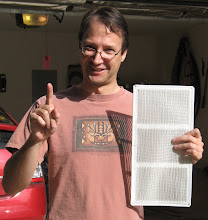Powering my home for a day in 2007, after my initial set of improvements, required anywhere from 9 to 37 kilowatt hours (kWh) of electricity, with the average being about 22 kWh.

To put that in human terms, when I ride hard on an exercise bike at the gym, I can generate around 100 Watts (0.1 kW), perhaps double that in short bursts, according to the readout attached to the bike. So riding hard for 1 hour, using my body to generate power, would yield 1 hour X 0.1 kW = 0.1 kWh. In fact, if I pedaled all day without drinking, eating, or sleeping, and used that energy to power my home, I would generate 24 hours X 0.1 kW = 2.4 kWh, slightly more than 10% of my energy use on an average day.
To extrapolate further, to power my relatively modest needs, I would need 10 people riding generator bikes 24 hours a day, for every day of the year. Of course, no one could keep that up... to allow for breaks for eating, sleeping, and recovery, I'd probably need 20 or 30 people, pedaling as much as they could stand, every day.
In other words, my energy needs go _way_ beyond what I can provide with human power.


Perhaps there are better and more efficient forms of "human power" devices that will yield more power per effort available. I know you can use super-conductivity to up the power factor by almost 100 by using a by-product of liquid oxygen production, liquid nitrogen if is is cheap. I doubt that the oil companies and other "powers that be" want us to know about that, but if enough of us can make it public, it will become reality someday.
ReplyDeleteIf nitrogen remains cheap for use as a refrigerate that is. Few know or understand how to use it to approach superconductivity to boost magnetic fields. I has and is being done under cover due to threats of life and property by those who do not want you to know about it.
ReplyDeleteIntriguing! However, as I understand the exercise bike at the gym, it's just measuring the power I put out; unless I'm mistaken, that's not making any assumptions about generator efficiency; it's just measure the work that I'm performing per unit time (i.e. power). I'd be thrilled to generate 1 kW riding my bike, but judging from sweat and heart rate for generating just a tenth of that, I doubt I can do so.
ReplyDeleteCheaper than superconductivity: I have seen studies that show that for just a slight increase in diameter of wires used to wire your home (at minimal cost), you can reap MANY times the materials cost in energy savings (reduced resistive losses). The problem: the same I've discovered in my Energy Efficiency travails. The folks _building_ the house are not the same as the folks _paying_ the utility bills. If we closed that loop, and made the builders pay even half the utilities for the first 5 years of occupancy, a LOT of better choices would be made, efficiency-wise.